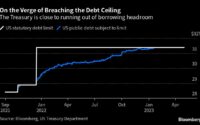Welcome to 1984 – Daily Reckoning Australia

I’ve been addressing the war on cash lately, and for good reason. While everyone’s attention is focused on the war in Ukraine, inflation, and the Supreme Court, government plans to eliminate cash are accelerating.
For example, central bank digital currencies (CBDCs) are coming faster than many anticipated. The digital yuan is already here; it was introduced in China last February during the Winter Olympics.
Visitors to the Olympics were required to pay for meals, hotels, transportation, etc., using QR codes on their mobile phones that linked to digital yuan accounts. Nine other countries have already launched CBDCs. Europe isn’t far behind and is testing the digital euro under the auspices of the European Central Bank.
The US was lagging but is catching up fast.
The Federal Reserve was studying a possible Fed CBDC at a research facility at MIT. Now the idea has moved from the research stage to preliminary development.
Fed Chair Jay Powell said:
‘A U.S. CBDC could…potentially help maintain the dollar’s international standing.’
But this has little to do with technology or monetary policy and everything to do with herding you into digital cattle chutes where you can be slaughtered with account freezes, seizures, etc.
NOT crypto
First off, CBDCs are not cryptocurrencies. CBDCs are digital in form, are recorded on a ledger (maintained by a central bank or finance ministry), and the message traffic is encrypted. Still, the resemblance to cryptos ends there.
The CBDC ledgers do not use blockchain, and CBDCs definitely don’t embrace the decentralised issuance model hailed by the crypto crowd. CBDCs will be highly centralised and tightly controlled by central banks.
The central bank can maintain the CBDC ledger in encrypted form without the need for bank accounts or money market funds. Payments can be made with an iPhone or other device, with no need for credit cards or costly wire transfers.
Who needs bank accounts, cheques, account statements, deposit slips, and the other clunky features of a banking relationship when you can go completely digital with the Fed?
CBDCs are a technological advancement, but they don’t replace existing reserve currencies.
Not a new currency
It’s important to understand that a CBDC is not a new currency. It’s just a new payment channel. A digital dollar is still a dollar. A digital euro is still a euro. It’s just that the currency never exists in physical form. It’s always digital, and ownership is recorded on a ledger maintained by the central bank.
You’ll have an account showing how many digital dollars you own. They are transferred by an app on a smartphone or a desktop computer.
Of course, in many ways, dollar transactions are already digital. Most people receive money by wire transfer, go shopping with credit cards, and pay bills online. All of those transactions are digital and encrypted. The difference with CBDCs is that you don’t need banks, credit card companies, or even PayPal.
Again, everything can be done through the Fed with a single account for payment and receipt. CBDCs could disintermediate the entire banking and credit card sectors to a great extent.
Welcome to 1984
The other big difference is that it will give the government the ability to control your money and put you under constant surveillance. In a world of CBDCs, it will be possible for the government to know every purchase you make, every transaction you conduct, and even your physical whereabouts at the point of purchase.
It’ll also make negative interest rates a lot easier to do, as well as account freezes, tax withholding from your account, and even putting you under FBI investigation if you vote for the wrong candidate or give donations to the wrong political party.
If that sounds like a stretch, it’s not.
China is already using its CBDC to deny travel and educational opportunities to political dissidents. Canada seized the bank accounts and crypto accounts of non-violent trucker protesters last winter.
These kinds of ‘social credit scores’ and political suppression will be even easier to conduct when CBDCs are completely rolled out.
How does this relate to what is sometimes called The Great Reset? This would be the movement toward a single global reserve currency.
CBDCs and The Great Reset
Displacing the dollar would involve a meeting and agreement like the original Bretton Woods agreement of 1944. The agreement could take many forms. The process would conform to what many call The Great Reset.
Still, things don’t happen that quickly in elite circles. Even Bretton Woods took more than two years to design and another five years to implement even under the duress of the Second World War. The transition from sterling to the US dollar as the leading reserve currency took 30 years from 1914 to 1944.
As they say, it’s complicated. Still, there are some huge changes that could emerge from The Great Reset.
For example, a new global currency regime would be an opportunity to devalue all major currencies to steal wealth from savers.
All currencies cannot devalue against all other currencies at the same time; that’s a mathematical impossibility. Yet all currencies could devalue simultaneously against gold. This could easily drive gold prices to $5,000 per ounce or much higher to increase the ‘inflation tax’ (I’m sure you agree that you’re paying more than enough already!).
The surveillance State on steroids
As noted, CBDCs make it much easier to impose negative interest rates, confiscations, and account freezes on some or all account holders.
This can be used for simple policy purposes or as a tool of the total surveillance State. Surveillance of incorrect behaviour as defined by the Communist Party is the real driver of the digital yuan more than any aspirations to a yuan reserve currency role.
All of these shifts are now underway. The US won’t adopt its own CBDC overnight, but it’s coming sooner or later.
The endgame for CBDCs would closely resemble George Orwell’s dystopian novel Nineteen Eighty-Four. It would be a world of negative interest rates, forced tax collection, government confiscation, account freezes, and constant surveillance.
Regards,
 |
Jim Rickards,
Strategist, The Daily Reckoning Australia
Editor’s note: Digital currency is coming to Australia. What could this mean for you? And, if you’re worried about the possible implications, what precautions can you take? Jim Rickards’ team have come up with a five-step plan to help protect at least some of your money; the first of which is to find out as much as you can about CBDCs. On that note, check out their latest presentation here…
[ad_2]
Source link


